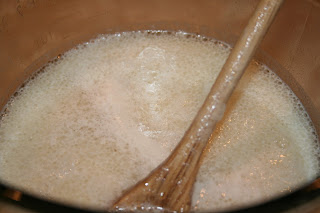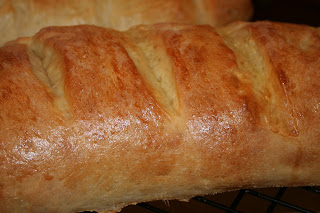Here's what you need:
2 1/2 cups warm water (110 - 115 degrees)
2 tablespoons instant rapid rise yeast
3 tablespoons sugar
2 tablespoons white vinegar
1 tablespoon salt (yes, tablespoon!)
1/3 cup vegetable oil
6 1/2 to 7 cups bread flour
1 egg, well beaten
1 tablespoon water
Extra vegetable oil for oiling bread rising bowl
Extra flour for kneading surface
Yellow cornmeal
Non-stick cooking spray
Thermometer, if necessary
 |
| Here's the end result! |
First, get your warm water to between 110 and 115 degrees. I suggest using a thermometer to check the temperature if you aren't an experienced bread baker. Too cool won't activate the yeast, and too warm will deactivate it. Add the yeast and sugar into the warm water and set aside. If you fail to get this beautiful foam action after about 5 to 8 minutes, discard and start over. Be sure to use fresh yeast - check the expiration date!
Once your yeast is happy, foaming away, add the vinegar, salt, and oil and stir in. You will actually need to use a larger container than I used to put my yeast in, which was a 4 cup measure. I had to transfer it to a larger bowl to add the vinegar, salt and oil. Use glass containers, by the way... not metal.
Next, measure your flour into a large mixing bowl. "Fluff" the flour by filling your measuring cup and dumping it back into the flour container 3 times before scooping up your cup to use. Do this each time you measure another cup, and you will avoid a dough that will be too dry due to too much flour. I start with 6 1/2 cups of flour, adding the liquid to it about a fourth at a time and mixing it in gently with a big old wooden spoon...
This is after the first 1/4 of the liquid is mixed...
mixing the second amount of liquid...
and here, I'm mixing in the last of the liquid.


After spreading some flour onto your kneading surface, place the dough onto it and knead for a full 10 minutes. This is where the "up to 7 cups" of flour comes in. You will need to add flour to your kneading surface until it's not sticky as you knead. Keep your hands floured as well. If you have never kneaded bread dough before, I suggest you check out a Youtube video so you can get a great visual on exactly how to do it properly. If you have little globs of dough stuck to your kneading surface, just get those out of the way by scraping them off with a bench scraper or the edge of a metal spatula. Keep your kneading surface smooth and "glob free". :)
Here's the dough after my 10 minutes of kneading.
Place it in a large oiled bowl, turn it to coat all around with the oil, then cover loosely with plastic wrap, leaving a vent hole, in a non-drafty place. It only takes this dough about 30 to 40 minutes to rise. You want it to double in size, or nearly.
Here it is, doubled. Now, lightly flour your kneading surface, and this time, knead only for about 4 minutes. Use much less flour, or none, only as much as required to prevent stickiness. Usually, the oil on the surface of the dough ball prevents stickiness at this point while kneading for such a short time. Return to the bowl, allow to rise again as before, and then repeat the process one more time. This will be a total of 3 times the dough will rise in the bowl.
After the third rise, using a sharp knife or bench scraper, divide the dough in half. Gently roll the two halves into logs and place them both on a large baking sheet which has been sprayed with non-stick cooking spray and lightly sprinkled with yellow cornmeal. Using a sharp knife, cut about 5 slashes into the top of each loaf, not cutting all the way through, as seen below.
Prepare an egg wash by whisking the egg in a small bowl well with a fork, then add the tablespoon of water and mix well again. Brush the egg wash all over the surface of the two loaves.
Bake the loaves at 375 in a pre-heated oven. I prefer using a shiny cookie sheet to bake mine on.
I set my timer for 25 minutes, and check the loaves at that point. I observe the color (you don't want them too dark, as seen here is perfect), and I tap the top of the loaves with my fingers and listen for a "hollow" sound. I gave these loaves another 2 minutes of baking after checking them. Every oven is different, and knowing when a bread is done comes with experience as well.
This bread has a thin, beautiful crust and a soft interior with a wonderful texture. This is the only French bread recipe I ever use.... it's so good! But I won't take my own word for it... I'll gladly verify that by cutting me a piece, slathering it with butter, and getting a true confirmation, so, 'scuse me while I go do that... while it's still warm from the oven.














No comments:
Post a Comment